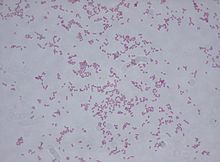| Klebsiella oxytoca | |
|---|---|

| |
| Gram stain | |
| Scientific classification | |
| Domain: | Bacteria |
| Phylum: | Pseudomonadota |
| Class: | Gammaproteobacteria |
| Order: | Enterobacterales |
| Family: | Enterobacteriaceae |
| Genus: | Klebsiella |
| Species: | K. oxytoca
|
| Binomial name | |
| Klebsiella oxytoca | |

Klebsiella oxytoca is a Gram-negative, rod-shaped bacterium that is closely related to K. pneumoniae, from which it is distinguished by being indole-positive; it also has slightly different growth characteristics in that it is able to grow on melezitose, but not 3-hydroxybutyrate. It was first described in 1886 when it was isolated from sour milk and named Bacillus oxytocus perniciosus (from Greek oxus 'sour' + -tokos 'producing').[1]
Klebsiella oxytoca is characterized by negative methyl red, positive VP, positive citrate, urea and TSI gas production, is AA, and negative for TSI sulfide, DNAse, growth on sulfide-indole motility medium and the phenylalanine deaminase test.
It is a diazotroph, able to colonise plant hosts and fix atmospheric nitrogen into a form which the plant can use. Association of K. oxytoca with the barley rhizosphere during an entire vegetative period has been demonstrated. The bacteria adhere strongly to root hairs, and less strongly to the surface of the zone of elongation and root cap mucilage.[2]
Like other enterobacteria, it is capable of acquiring antibiotic resistance, and isolates have been shown to produce extended-spectrum beta-lactamases as well as carbapenemases.[3]
- ^ Flügge, Carl (1886). Die Mikroorganismen. Leipzig: F.C.W. Vogel.
- ^ Brisse S, Grimont F, Grimont PA (2006). Prokaryotes. New York, NY: Springer New York. pp. 159–196. ISBN 9783540325246.
- ^ Hoenigl, Martin; Valentin, Thomas; Zarfel, Gernot; Wuerstl, Benjamin; Leitner, Eva; Salzer, Helmut J. F.; Posch, Josefa; Krause, Robert; Grisold, Andrea J. (2012-04-01). "Nosocomial Outbreak of Klebsiella pneumoniae Carbapenemase-Producing Klebsiella oxytoca in Austria". Antimicrobial Agents and Chemotherapy. 56 (4): 2158–2161. doi:10.1128/AAC.05440-11. ISSN 0066-4804. PMC 3318378. PMID 22290949.